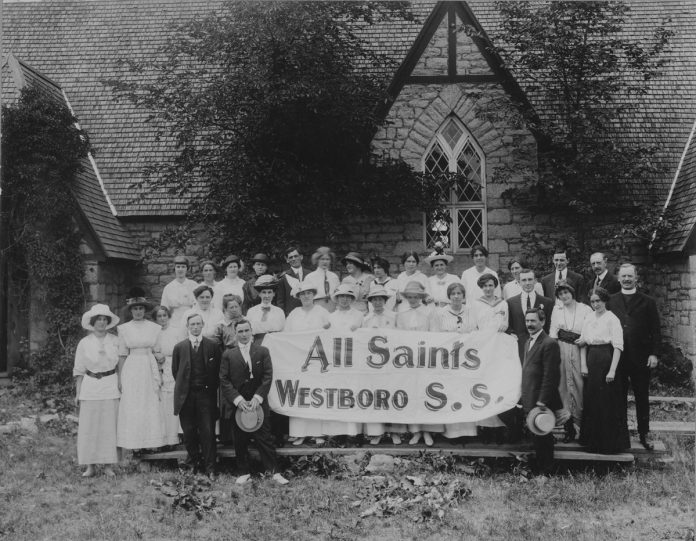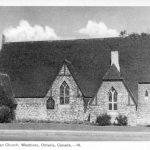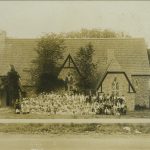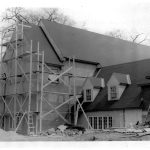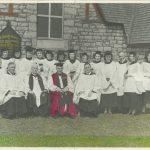By Bob Grainger –
On the second Tuesday of June 1865, there was a ceremony to lay the cornerstone for the construction of All Saints’ Church on the north side of Richmond Road in the very centre of what was to become the Village of Westboro.
The Union newspaper described it as follows:
On the 15th inst., the cornerstone of the new Church was laid by his Lordship the Bishop of the Diocese of Ontario (Rt. Rev. John Travers Lewis) on the farm of Messrs. John and William Thomson, Richmond Road. The site of the church is beautifully situated on the north side of the road, about the commencement of Mr. Thomson’s farm, in the vicinity of the School house. The piece of ground on which the sacred edifice is to be built has been liberally granted for the purpose by the Messrs. Thomson. The day was beautifully bright, and the green surrounding foliage in the vicinity had a most pleasing effect. Two o’clock was the hour appointed for the laying of the stone. Punctual to the time, a goodly number of ladies and gentlemen, both of the township and city, had assembled.
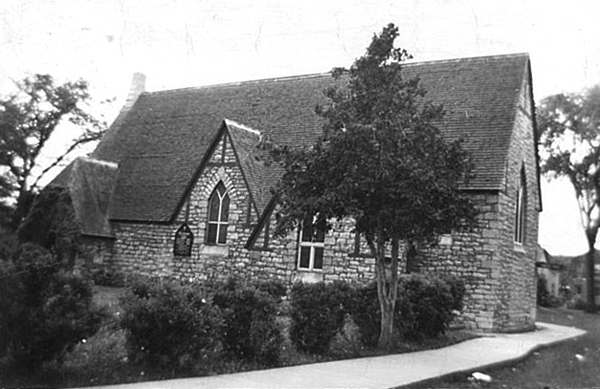
Among the local dignitaries that day were Thomas Fuller, the architect of the plans for the church, and James Skead, a local businessman who would soon be appointed Senator. After the ceremony, the dignitaries were invited for lunch to the “hospitable cottage” of Mr. and Mrs. G.B. Pelham on the northeast corner of Richmond Road and Kirkwood Avenue.
All Saints’ Church is the oldest surviving structure in Westboro. When it was built, it stood at a dusty crossroad in a rural township. The church was designed for a congregation of approximately two hundred people, but it was quite a few years before this number was reached.
This church has been witness to a lot of local history. It was two years old at the time of Confederation; it was 31 years old when the “new” Nepean Township Hall was built right next door in 1896 (the previous Township Hall had been located in Hintonburg which was annexed into the City of Ottawa); it was 34 years old when the name of the community was changed from Skead’s Mills to Westborough in 1899; it was 40 years old when Westboro was recognized as a Police Village inside Nepean Township in 1905; and 85 years old in 1950 when this location and a large area of the Township was annexed to the City of Ottawa.
In 1865, the population of the immediate area was very small. Even in 1881, sixteen years later, there were only two hotels, one grocery store, and 31 families living here. The economic activity of the area at this time centred on the Ottawa River, with the flow of logs moving down to the large mills at the Chaudière Falls.
It was the Thompson Boom, located offshore from Westboro Beach, which was responsible for a good share of the economic activity of the local area. The Thompson Boom, the creation of the Upper Ottawa Boom Commission, was the last control point on the Ottawa River before the mills at the Chaudière. When the mills ran out of logs, a message would be sent to the Thompson Boom to open the boom and release several hundred more logs for the trip downstream. The rivermen would ride downstream with the logs, using their tools, (the peevy and the pike pole), to prevent the formation of log jams and keep the logs in the current in the middle of the river. Having delivered the logs safely to the Chaudière, the rivermen would start the long walk back to shepherd another group of logs downstream. They would return along a long and dusty Richmond Road, and along that route they’d be tempted to quench their thirst at one of the hotels in early Westboro.
With the construction of Skead’s sawmill and the Canada Central Railway in 1869 came more local jobs and population and commercial enterprises and market gardens – and the congregation of All Saints’ Church grew along with the village.
Material from the Union newspaper courtesy of Peter Robertson, All Saints’ Church.
Bob Grainger is a retired federal public servant with an avid interest in local history. KT readers may already know him through his book, Early days in Westboro Beach – Images and Reflections. He’s also part of the Woodroffe North history project and is currently working on the history of Champlain Park and Ottawa West. Do you have early memories of All Saints’ you’d like to share with KT readers? Send your feedback to ?stories@kitchissippi.com.
A year of celebration
All Saints’ 2015 event calendar is full of activities the public is invited to attend, including Jazz Vespers and Celtic Vespers. This year there will be a host of other events to celebrate All Saints’ 150th anniversary.
January 24: Anniversary Gala Dinner (Friends of All Saints’ are welcome!)
March 8: Anniversary Concert Series: St. John’s Strings
April 11: Anniversary Concert Series: Ottawa Celtic Choir and Toronto Welsh Male Choir
April 19: 150th Anniversary Service
May 2: “Let the People Sing” Interfaith Community Choral Concert
May 22: Anniversary Concert Series: Nepean High School Choir
June 7: History walk and parish picnic
September 13: All Saints’ Anniversary corn roast in the courtyard
Stay tuned to the All Saints’ website as well as the KT community calendar and Facebook page for details of upcoming events.
Click photos to enlarge:
